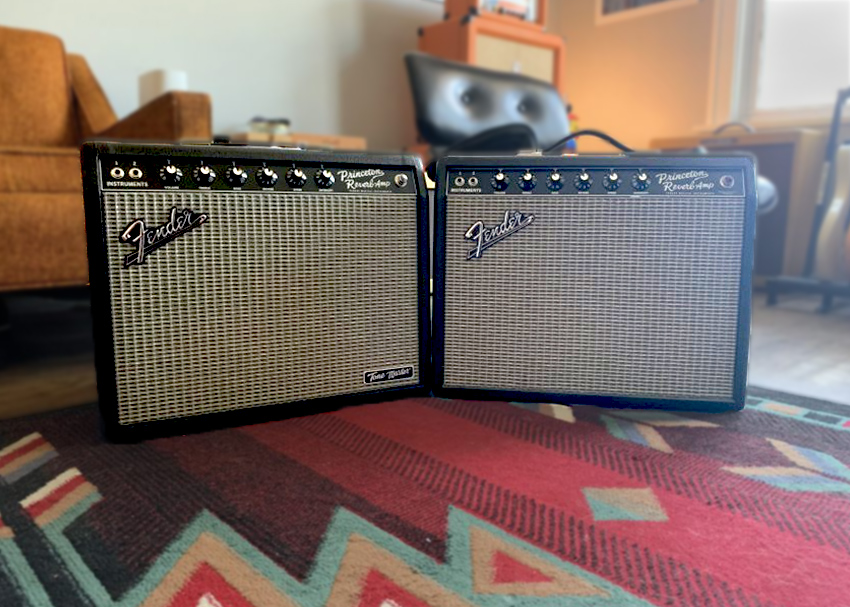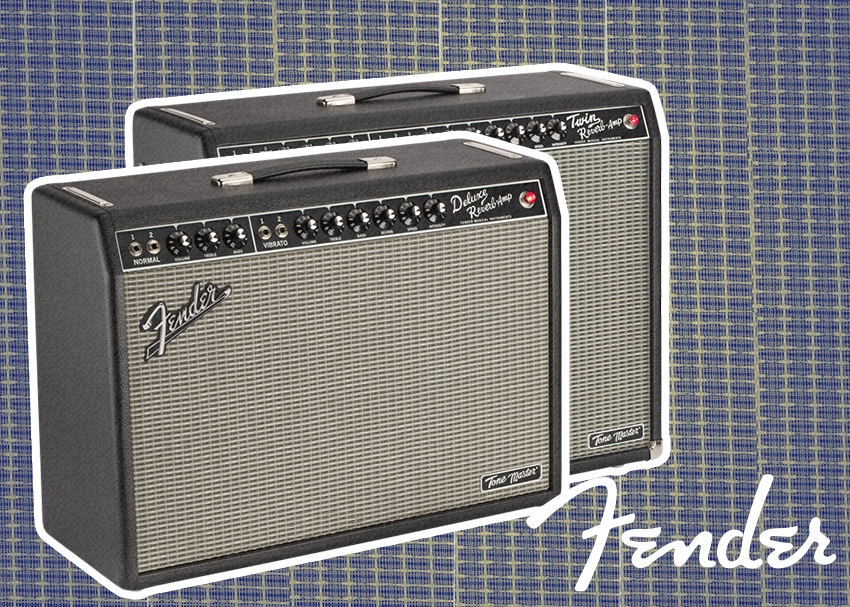When the Fender Tone Master Princeton Reverb was announced, I was pretty intrigued. I’ve played my ’65 Princeton Reverb for a long time now, and it has become one of my favorite guitar amp designs of all time. Nothing on my amp has been modified, so I thought it would be fun to compare the two amps.
While the Tone Master Princeton is lighter, the original isn’t that much heavier than its digital cousin. The bigger amps to get a Tone Master edition, like the Super Reverb and Twin Reverb, see a much bigger difference when it comes to weight savings. The ’65 Princeton Reverb isn’t that heavy to begin with, which is one of the many reasons why it’s loved by gigging musicians in the first place.
Instead of doing a dead-on comparison between the two amps, I thought it would be more beneficial to show what is different with the Tone Master Princeton Reverb compared to the ’65 Princeton Reverb. Toward the end, I’ll have some audio clips of each. See (I mean, hear) if you can tell the difference!
Related: Fender Tone Master Amps: The Cutting Edge of Timeless Tone
Learn what makes Fender Tone Master amps not only sound like their original counterparts, but behave like them too. | Read »
The Differences
First up is the Tone Master Princeton Reverb. There are several new additions to the back of the amp that take advantage of the DSP-powered internals. One of the best features on the Tone Master is power scaling that acts like a conventional attenuator. Power levels range from .3 watts to 12 watts, which is plenty loud for playing out at a gig. Having the ability to bring down the volume of the amp while still being able to push it into overdrive is great for smaller clubs and for playing at home. There is also a balanced XLR output with three modes — no cabinet simulation and two other cabinet simulations that emulate a Shure SM57 and Royer R-121. Also found on the back of the amp is a mute switch that can be engaged if you’re using the XLR output.
The Similarities
Perhaps the greatest strength across the entire Fender Tone Master line is that the control panels are the same as the original tube amps. The main gripe I have with other digital amps is trying to figure out what all the controls do. Just looking at an amplifier’s control layout will tell you a good amount of information even before plugging in a guitar. Everything on the Tone Master amps works just like the original versions did when they came out in the mid-1960s. Why add more knobs when it’s just unnecessary? The only indicator from the front is a little Tone Master badge on the bottom right-hand corner of the grill cloth.
Who is the Tone Master Princeton for?
With the tube shortage that was experienced in 2022, tube amp players started to worry. Brands like Fender started to put forth a bigger effort to cater to those who wanted the look and functionality of their beloved tube amps, but with none of the tubes. After all, guitar players are really the last humans on Earth that still use this technology.
The Tone Master Princeton Reverb responds and functions like the tube-powered version. There’s no need to fiddle with impulse responses, amplifier profiles, or controls that weren’t on the original design. This is where some other digital amps can be a little overwhelming. Most people just need to plug in and start playing rather than fiddling with settings for half an hour before getting a viable tone.
Let’s test your ears
Whether you can hear (or feel) the difference is up to you as the player. As the saying goes, “beauty is in the eye of the beholder.” There will be three different tones, all using a Shure SM57 in front of each amplifier in the same position. All three playing examples will have their tones matched by ear rather than using the same exact same settings. While these amps do have the same controls, each amp breaks up at a different volume, has a little bit different of an EQ curve, and has reverb with a slightly different mix. Instead of just doing a straight ahead shootout, I’m going to use my ears rather than my eyes to do each of these amplifiers some justice.
Each playing example will have one amp after the other. Three different guitars were used in each clip to give some variety. First up is my Fender Stratocaster in position two for a tone that only a Strat can make. The amps were set up clean, which is a great platform for pedal enthusiasts. The second clip is typically how I run my ’65 Princeton Reverb, which I think is the sweet spot for these amps. My trusty 70th Anniversary Fender Broadcaster on the bridge pickup was a treat to play through both of these amps. Lastly is my Gibson Les Paul with the amps almost wide open. If I’m honest, the room was a bit loud when I recorded these clips.
Can you tell the difference?
My thoughts
This blog was never meant to share my own opinions. It is much more beneficial to just give some facts and some playing examples, but I did find some interesting things about the Tone Master that differ from my tube amp. These two amps sound extremely similar, but behave differently from a controls point of view. The more you push the tube-powered version, the more low end you get out of the amplifier. Usually to compensate for this, I’ll adjust the treble and bass controls. The Tone Master did need tweaking like its tube counterpart, but needed the opposite to compensate for the extra saturation. To be clear, I had to add bass and take away some treble on the Tone Master as the amp went into overdrive. I found this very interesting, since there’s really no other way to find this out unless the digital amp is a recreation of a tube amp.
Why pick the Tone Master over the original version?
The on-board power scaling mode is enough to sell anyone who wants an amp that will behave the same on stage as it will while you’re practicing. The amp sounds and feels really close to the tube-powered cousin. You can still change the speaker in the Tone Master, which will definitely be the first, if not only modification, that people will do to these. There’s a USB output for when Fender has updates on the amplifier modeling so these amps won’t go obsolete after a year of ownership. After all of that, you still have the stage volume and tone that an amplifier can really only provide. It’s not the most extreme step into the digital age, but it’s one that feels very familiar.
The age of digital amps not keeping up with tube amps is coming to an end. A lot of touring musicians use various kinds of floorboard units with impulse responses, powered cabinets on stage, and the band just uses in-ear monitors. If digital amps are good enough to be toured with, then it’s probably time to give one of them a shot. The Tone Master series is the perfect lineup of amps that stubborn people like myself will try out. There are certainly some features that improve the design, but do not get in the way of the spirit of the amp.




